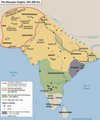Bestand:Standard Mauryan Empire.png
Uiterlijk

Grootte van deze voorvertoning: 499 × 599 pixels. Andere resoluties: 200 × 240 pixels | 400 × 480 pixels | 640 × 768 pixels | 853 × 1.024 pixels | 1.706 × 2.048 pixels | 3.054 × 3.666 pixels.
Oorspronkelijk bestand (3.054 × 3.666 pixels, bestandsgrootte: 1,21 MB, MIME-type: image/png)
Bestandsgeschiedenis
Klik op een datum/tijd om het bestand te zien zoals het destijds was.
| Datum/tijd | Miniatuur | Afmetingen | Gebruiker | Opmerking | |
|---|---|---|---|---|---|
| huidige versie | 9 feb 2024 07:35 |  | 3.054 × 3.666 (1,21 MB) | Buddhamitra sangha | More clarification |
| 8 feb 2024 00:37 |  | 3.054 × 3.666 (1,21 MB) | Buddhamitra sangha | Quality | |
| 8 feb 2024 00:10 |  | 3.054 × 3.666 (695 kB) | Buddhamitra sangha | Ceded area correction | |
| 8 dec 2023 06:50 |  | 3.054 × 3.666 (1,43 MB) | Buddhamitra sangha | Uploaded own work with UploadWizard |
Bestandsgebruik
Dit bestand wordt op de volgende pagina gebruikt:
Globaal bestandsgebruik
De volgende andere wiki's gebruiken dit bestand:
- Gebruikt op ba.wikipedia.org
- Gebruikt op ca.wikipedia.org
- Gebruikt op hi.wikipedia.org
- Gebruikt op hu.wikipedia.org
- Gebruikt op simple.wikipedia.org
- Gebruikt op te.wikipedia.org
- Gebruikt op wuu.wikipedia.org
- Gebruikt op zh.wikipedia.org
